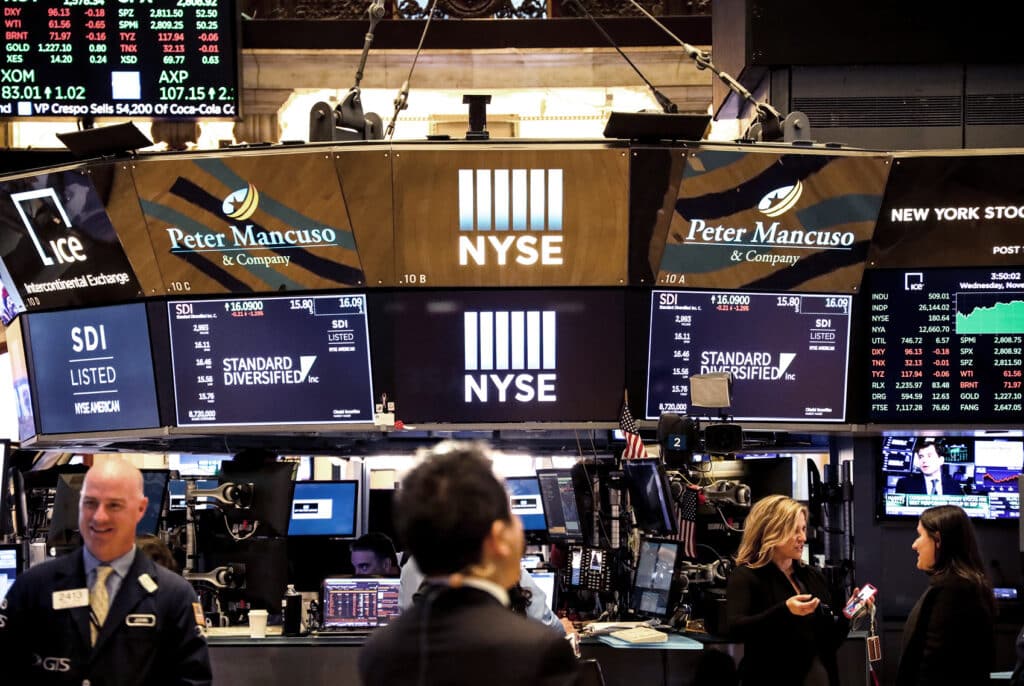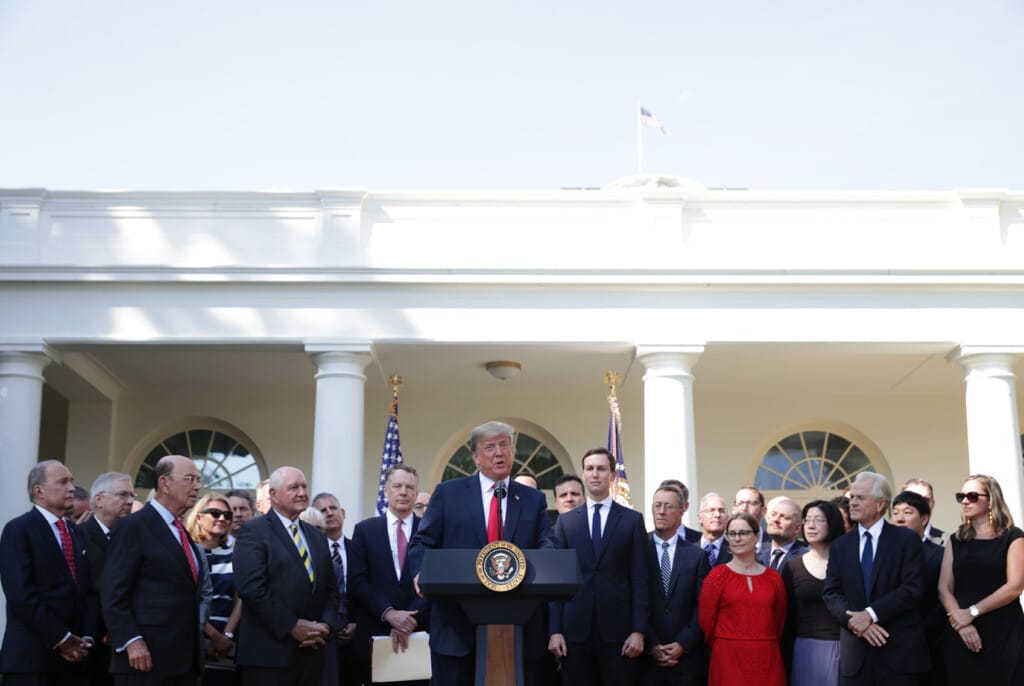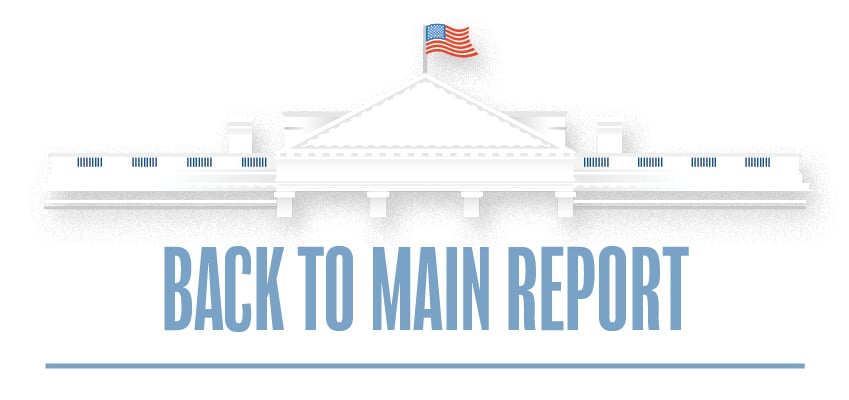January 31, 2019 |
Midterm Assessment: Economic Security
Contents
January 31, 2019
Midterm Assessment: Economic Security
Current Policy
The Trump administration has pursued a series of national economic security policies that recognize and address the growing convergence of economics and security. From the start, the administration has made clear that “economic security is national security.”1
This premise has translated into an aggressive approach to prioritizing American economic interests in light of growing competition between great powers, as described in the 2017 National Security Strategy. Specifically, the administration’s approach reflects the president’s suspicion of existing trade agreements and a challenge to the orthodoxy that greater economic integration globally is necessarily beneficial to U.S. interests. The administration has also demonstrated its willingness to act unilaterally and aggressively, and to, in blunt strokes, use a variety of trade, regulatory, enforcement, and economic tools against all actors, including U.S. allies. In particular, it has confronted China directly about a wide spectrum of perceived threats to U.S. interests, from trade inequities and manufacturing chokepoints to cyber-enabled economic warfare and the theft and forced transfer of intellectual property.
Reflecting the president’s suspicion of major trade agreements, the administration withdrew from, or demanded renegotiation of, existing deals, such as the North American Free Trade Agreement (NAFTA), the Trans-Pacific Partnership Agreement (TPP), and the South Korean free trade agreement (KORUS). It also imposed tariffs – often citing “national security” reasons and exemptions – on foreign goods, including from Canada, Europe, and Asia. The most intense trade battle has emerged with China, with escalating tariffs and threats of more restrictions and regulatory or enforcement actions for unfair and imbalanced Chinese trade practices.
The administration has also sought to defend American economic interests, technology, and intellectual property by mandating broader investment protections, imposing export controls, and encouraging collaboration with the private sector. In particular, the administration has prioritized the protection of the technology and manufacturing sectors that it considers crucial to U.S. innovation, economic development, and national security.
Like its predecessors, the Trump administration has continued the aggressive use of financial and economic tools of coercion – especially sanctions – to target and isolate rogue actors (state and non-state) from the global economic and financial system. In its first two years, the administration often employed sanctions unilaterally, as illustrated by its withdrawal from the Iran nuclear deal and snapback of prior sanctions; the aggressive implementation of North Korean-related sanctions, including against Chinese actors; and the expansion of existing authorities to address human rights violations, corruption, cyber threats, and other diplomatic hotspots (like Venezuela and Nicaragua). In 2018 alone, the administration added almost 1,500 names to the Specially Designated Nationals list administered by the Treasury Department’s Office of Foreign Assets Control.
The administration has also ensured that its actions – in particular against Iran, North Korea, and Venezuela – underscore the inherent illicit financing risks associated with doing business in and through those countries, especially with their governments. Sanctions, advisories, and indictments have all been used to target suspect actors and draw attention to financial security concerns.
Finally, the administration took an important step to leverage America’s positive economic power when President Trump signed the Better Utilization of Investment Leading to Development (BUILD) Act, which passed with wide bipartisan support in the House and Senate. The act modernizes U.S. development finance and improves the government’s ability to deploy incentives to address the increasingly important need for alternatives to China’s aggressive state-lending model. The intent of this new legislation is to catalyze flows of private capital to build robust private sectors in higher-risk developing countries while providing new opportunities for the U.S. private sector and supporting U.S. national security goals.

Traders on the floor of the New York Stock Exchange on the evening of November 7, 2018 in New York City. (Photo by Alex Wroblewski/Getty Images)
Assessment
The Trump administration has woven together the beginnings of a national economic security policy by focusing in the first instance on defending American economic prosperity and interests, and by using a variety of coercive tools to reshape the geo-economic landscape. Often, the specific measures have been seen as harsh and blunt – lacking concern for allied interests or long-term effects, and often leveraged without a coordinated strategy or concern for negative externalities.
The administration’s aggressive trade agenda has, in some cases, resulted in new trade deals with allies, notably the renegotiated NAFTA (now the United States, Mexico, Canada Agreement, or USMCA), and a revised U.S.-Korea free trade deal. In USMCA, the parties agreed that any new trade deal with a non-market economy (China) could lead to the termination of USMCA.2 The administration also secured an agreement in principle from the European Union for freer, fairer, and more reciprocal trade. Despite its withdrawal from TPP, the administration has tried to increase economic cooperation with countries in the Indo-Pacific, focusing on streamlining high-tech exports to India, and enhancing energy cooperation to expand the market for U.S. exports.3
The administration’s approach to China reflects both the president’s emphasis on reducing the U.S.-China trade deficit, as well as widely shared concerns about China’s predatory economic behavior. This behavior includes cyber-enabled and traditional economic espionage, unfair licensing practices, forced technology transfers, and joint venture requirements for U.S. companies seeking access to the Chinese market. The administration has levied tariffs on $250 billion in Chinese imports to the U.S., yet Beijing has not yet agreed to, or implemented, wide-ranging policy changes such as opening up its markets or halting its relentless efforts to steal intellectual property.
Greater clarity has come from U.S. legislation to protect America’s technological and manufacturing bases from China’s aggressive efforts to acquire American technology and intellectual property (IP). The Export Control Reform Act (ECRA) expands the scope of technology under U.S. export control jurisdiction to include “emerging and foundational technologies.”4 Meanwhile, the Foreign Investment Risk Review Modernization Act (FIRRMA) expands the jurisdiction and powers of the Committee on Foreign Investment in the United States’ (CFIUS) national security review process by increasing the scope of “covered transactions” subject to mandatory review.5 Even before FIRRMA was signed, the administration had begun scrutinizing investments in the United States regarding sensitive technology, as seen in the intervention to block the proposed Broadcom/Qualcomm acquisition.
Through the use of coercive tools, the administration has exerted pressure effectively on rogue state adversaries.
Through the use of coercive tools, the administration has exerted pressure effectively on rogue state adversaries. The return of sanctions on Iran has severely weakened Tehran’s currency while driving up inflation. Sanctions and indictments against Venezuelan officials have revealed not only widespread corruption in the Maduro regime, but also its close ties to, and at times active participation in, narcotics trafficking. Four successive UN Security Council resolutions advanced Washington’s “maximum pressure” campaign against North Korea, which may have put pressure on Kim Jong Un to cease provocations such as missile launches. Russia and Hezbollah have also found themselves in the crosshairs of additional U.S. sanctions.
Finally, the implementation of the Global Magnitsky Act represents a significant milestone in the use and expansion of conduct-based sanctions, enabling the U.S. to target corruption and human rights abuse globally. Targets to date include the former president of Gambia, numerous Nicaraguan officials, two Turkish cabinet ministers, Burmese commanders involved in the ethnic cleansing of Rohingya Muslims, and 17 Saudi officials involved in the murder of Jamal Khashoggi.

Joined by members of his cabinet and employees from the office of the U.S. Trade Representative, U.S. President Donald Trump speaks during a press conference to discuss a revised U.S. trade agreement with Mexico and Canada on October 1, 2018 in the Rose Garden of the White House. (Photo by Chip Somodevilla/Getty Images)
Recommendations
To establish an effective and sustainable national economic security policy, the administration must develop a more strategic, nuanced, and multilateral approach that builds on steps already taken.
- Coordinate and prioritize an economic security strategy. The Trump administration needs to choreograph and coordinate the implementation of an overarching national economic security strategy with allies and the private sector, incorporating all existing authorities and tools.
- Resolve disputes with friends and shift the focus to China. The administration’s “America First” economic policy comes at a time when all Western economies are grappling with China’s alternative economic security model. When a major global economy does not subscribe neatly to existing international rules and norms, it challenges all nations that do. With this in mind, the Trump administration should calibrate and resolve trade disputes with allies to allow for a collective focus on Chinese challenges – and revisit reentry into the TPP with a sharper eye toward reinforcing U.S. national economic security goals multilaterally.
- Develop trade negotiations with a clear priority to protect U.S. intellectual property, defense of the U.S. innovation base, and access and opportunities for U.S. companies and interests in foreign markets. The focus of all negotiations should be on defending American interests against explicit economic attacks. This includes defending against Chinese cyber-enabled economic warfare and ensuring China is not able to engage in trade arbitrage that undercuts controls.
- Define the boundaries of state intervention. Protecting U.S. national economic security requires government intervention in the marketplace, which limits the freedom of the private sector. To the extent that the U.S. government begins to block or exclude investments under CFIUS, impose tariffs for “national security reasons,” or support private actors’ efforts to access new markets, it will need to define clearly the rules of the road. This should include clear definitions of how the U.S. government will intervene in mergers, acquisitions, and investments in sensitive or critical U.S. technology, supplies, and manufacturing – including with early-stage investments.
- Use sanctions selectively. Sanctions programs and financial tools of exclusion must be used selectively as an asymmetric tool of value, focused on underlying illicit or nefarious conduct, which justifies such isolation. The U.S. should ensure that such steps – even if unilateral – serve to reinforce international norms and requirements, rather than becoming solely tools of punishment that advance U.S. interests. This will help drive cooperation with allies and compliance in the private sector.
- Forge defensive economic security alliances. The administration should encourage our allies to coordinate their efforts to review and vet Chinese investment in key technologies, such as telecommunications, artificial intelligence, and quantum computing. This is already happening in part with evaluations and withdrawal of deals involving Chinese telecom giant Huawei. Cyber defense and supply-chain security should be top priorities.
- Forge positive economic security alliances. The U.S. government should coordinate with key allies to ensure investment in critical countries and on projects that are important to U.S. national economic security goals. This might include targeted investment in countries already influenced by China, Russia, North Korea, or Iran. There should also be a complementary CFIUS process that qualifies appropriate investment from around the world for preferred access to sensitive projects or technologies. This process should unlock and catalyze new capital, including from allied sovereign wealth funds.
- Engage the private sector. The administration must coordinate and cooperate with the private sector, including critical infrastructure firms, technology companies, and the investor community. This should involve sharing information dynamically and actively defending against state actors trying to steal intellectual property, disrupt business operations, and exert destructive economic influence against American interests.
